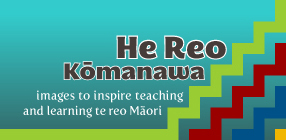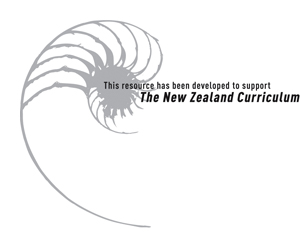Sample teaching and learning task sequences
The following sequences of teaching and learning tasks are suggestions that demonstrate how the images and the suggested framework may be used to form the basis of varied and stimulating student-centred lessons. To be effective, lessons in te reo Māori will include meaningful te reo Māori input, guessing from context, productive student interaction, clarification by the teacher, and fluency practice. They will also incorporate all six language modes.2
The intention of these sample task sequences is not that teachers will follow them in every detail. Te Aho Arataki Marau mō te Ako i Te Reo Māori - Kura Auraki/Curriculum Guidelines for Teaching and Learning Te Reo Māori in English-medium Schools: Years 1-13 stresses the importance of teachers taking an inquiry approach to teaching so that they are able to tailor their planning to the diverse strengths, needs, and interests of the students for whom they are responsible. It suggests a Teaching as Inquiry cycle for te reo Māori that is an adaptation of the generic Teaching as Inquiry cycle in The New Zealand Curriculum (pages 34, 35). This cycle requires teachers to make decisions, based on evidence, about what students need to learn next, and the strategies likely to be most effective in helping them to learn. Part of this decision making involves a consideration of ways to recognise the principles of the NZC (page 9), and ways to integrate a focus on the values (NZC page 10) and the key competencies (pages 12, 13) of the NZC.
The sample task sequences are linked to particular achievement objectives in the guidelines but do not specify learning outcomes or success criteria. Teachers will develop learning outcomes with their own students in mind and will develop success criteria in partnership with their students. The guidelines discuss this process in the section on monitoring achievement.
Teachers will think of many creative ways in which to modify the task sequences to suit their students’ competencies and needs and to enable their students to achieve their intended learning outcomes. For example, teachers may prefer to vary the tasks by:
- creating their own texts, focusing on particular parts of the given information or on their own knowledge of the topic and including vocabulary or grammar points they wish to teach;
- allowing their students access to the English text to supplement information and promote further discussion;
- facilitating collaborative inquiry (for example, by providing further written information in class) rather than having the students undertake the inquiry process independently;
- having the students convert their mind maps into posters at the presentation stage;
- employing different ways of presenting information as groups or individuals and to varied audiences (for example, to their own class, other classes, their parents, people at the local marae or in other community groups) and using different media (for example, oral, PowerPoint, audio- or videotape).
- using the Grammar Dictation procedure to replace Steps 3–4 of the general framework (reading and discussion);
- using the text as a listening task instead of reading task. However, if the text is used as a listening task, it is advisable to make the written text available to the students later in the lesson. This is because reading offers students more time to focus on the new vocabulary and sentence patterns, maximising learning opportunities and increasing retention.
- There are six language modes: listening, speaking, viewing, reading, writing, and presenting.


